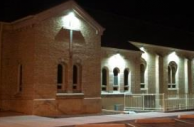
Community buildings, such as churches and village halls, pubs and shops and schools may have long 'on' hours, due to occupancy or aesthetics (see above).
If your lights are on for more than 10 hours per day (or night), your payback for upgrading to LED lighting may be as little as 1 year. The quality of light is better, maintenance is minimal (LEDs last years longer), making for a safer building.
You use 50-90% less electricity, there's no flicker, no ultra-violet, no mercury and no 'warm-up' time!
Making a difference...
...in your community.
If you are open most of the day most days (e.g. shop, school, church hall, doctors' surgery, pub), have a mixed stock of buildings, and where the energy users are unaware of the costs of provision, your energy costs are rising, but your funding may be under pressure.
20% Challenge focuses on inefficient equipment and 'bad habits', building awareness; establishing common energy-management goals; measurement of utility use; championing of success and progress review.
Case Study
Monkton's 'green' group, Sustainability at Monkton (SAM), enables pupils to make a difference in school life.

Members of SAM have challenged energy-wasteful habits in Switch-Off Fortnight, initiated recycling of classroom materials, and are focussing their efforts to reducing food waste and water use. Along with support and advice from 20% Challenge, Monkton has reduced it's utility spend by £12,000 saving 60Tonnes CO2, whilst raising the profile of Sustainability to all areas of the school.
SAM has monitored gas and electricity use, achieved a 20% reduction in electricity consumption during Switch-Off Fortnight, won an award in Co-Op's Green Schools Revolution.
Pupils have also planted 420 native trees in school grounds (pictured), established a weekly bee-keeping course and a bee-friendly garden, together with the purchase of its own hive and bee colony.